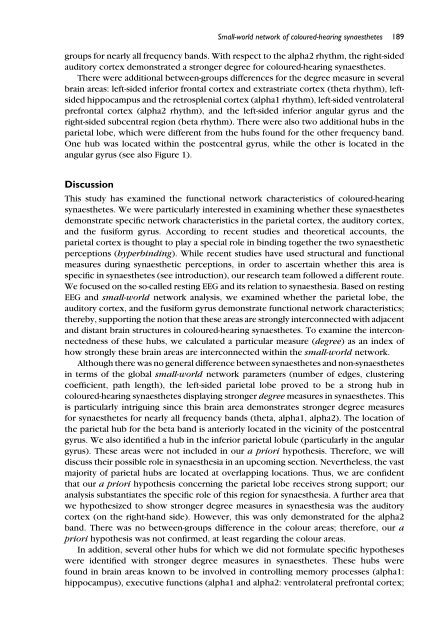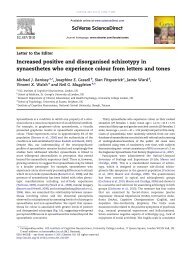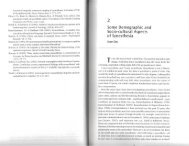A strong parietal hub in the small-world - Synesthesia
A strong parietal hub in the small-world - Synesthesia
A strong parietal hub in the small-world - Synesthesia
You also want an ePaper? Increase the reach of your titles
YUMPU automatically turns print PDFs into web optimized ePapers that Google loves.
Small-<strong>world</strong> network of coloured-hear<strong>in</strong>g synaes<strong>the</strong>tes 189<br />
groups for nearly all frequency bands. With respect to <strong>the</strong> alpha2 rhythm, <strong>the</strong> right-sided<br />
auditory cortex demonstrated a <strong>strong</strong>er degree for coloured-hear<strong>in</strong>g synaes<strong>the</strong>tes.<br />
There were additional between-groups differences for <strong>the</strong> degree measure <strong>in</strong> several<br />
bra<strong>in</strong> areas: left-sided <strong>in</strong>ferior frontal cortex and extrastriate cortex (<strong>the</strong>ta rhythm), leftsided<br />
hippocampus and <strong>the</strong> retrosplenial cortex (alpha1 rhythm), left-sided ventrolateral<br />
prefrontal cortex (alpha2 rhythm), and <strong>the</strong> left-sided <strong>in</strong>ferior angular gyrus and <strong>the</strong><br />
right-sided subcentral region (beta rhythm). There were also two additional <strong>hub</strong>s <strong>in</strong> <strong>the</strong><br />
<strong>parietal</strong> lobe, which were different from <strong>the</strong> <strong>hub</strong>s found for <strong>the</strong> o<strong>the</strong>r frequency band.<br />
One <strong>hub</strong> was located with<strong>in</strong> <strong>the</strong> postcentral gyrus, while <strong>the</strong> o<strong>the</strong>r is located <strong>in</strong> <strong>the</strong><br />
angular gyrus (see also Figure 1).<br />
Discussion<br />
This study has exam<strong>in</strong>ed <strong>the</strong> functional network characteristics of coloured-hear<strong>in</strong>g<br />
synaes<strong>the</strong>tes. We were particularly <strong>in</strong>terested <strong>in</strong> exam<strong>in</strong><strong>in</strong>g whe<strong>the</strong>r <strong>the</strong>se synaes<strong>the</strong>tes<br />
demonstrate specific network characteristics <strong>in</strong> <strong>the</strong> <strong>parietal</strong> cortex, <strong>the</strong> auditory cortex,<br />
and <strong>the</strong> fusiform gyrus. Accord<strong>in</strong>g to recent studies and <strong>the</strong>oretical accounts, <strong>the</strong><br />
<strong>parietal</strong> cortex is thought to play a special role <strong>in</strong> b<strong>in</strong>d<strong>in</strong>g toge<strong>the</strong>r <strong>the</strong> two synaes<strong>the</strong>tic<br />
perceptions (hyperb<strong>in</strong>d<strong>in</strong>g). While recent studies have used structural and functional<br />
measures dur<strong>in</strong>g synaes<strong>the</strong>tic perceptions, <strong>in</strong> order to ascerta<strong>in</strong> whe<strong>the</strong>r this area is<br />
specific <strong>in</strong> synaes<strong>the</strong>tes (see <strong>in</strong>troduction), our research team followed a different route.<br />
We focused on <strong>the</strong> so-called rest<strong>in</strong>g EEG and its relation to synaes<strong>the</strong>sia. Based on rest<strong>in</strong>g<br />
EEG and <strong>small</strong>-<strong>world</strong> network analysis, we exam<strong>in</strong>ed whe<strong>the</strong>r <strong>the</strong> <strong>parietal</strong> lobe, <strong>the</strong><br />
auditory cortex, and <strong>the</strong> fusiform gyrus demonstrate functional network characteristics;<br />
<strong>the</strong>reby, support<strong>in</strong>g <strong>the</strong> notion that <strong>the</strong>se areas are <strong>strong</strong>ly <strong>in</strong>terconnected with adjacent<br />
and distant bra<strong>in</strong> structures <strong>in</strong> coloured-hear<strong>in</strong>g synaes<strong>the</strong>tes. To exam<strong>in</strong>e <strong>the</strong> <strong>in</strong>terconnectedness<br />
of <strong>the</strong>se <strong>hub</strong>s, we calculated a particular measure (degree) asan<strong>in</strong>dexof<br />
how <strong>strong</strong>ly <strong>the</strong>se bra<strong>in</strong> areas are <strong>in</strong>terconnected with<strong>in</strong> <strong>the</strong> <strong>small</strong>-<strong>world</strong> network.<br />
Although <strong>the</strong>re was no general difference between synaes<strong>the</strong>tes and non-synaes<strong>the</strong>tes<br />
<strong>in</strong> terms of <strong>the</strong> global <strong>small</strong>-<strong>world</strong> network parameters (number of edges, cluster<strong>in</strong>g<br />
coefficient, path length), <strong>the</strong> left-sided <strong>parietal</strong> lobe proved to be a <strong>strong</strong> <strong>hub</strong> <strong>in</strong><br />
coloured-hear<strong>in</strong>g synaes<strong>the</strong>tes display<strong>in</strong>g <strong>strong</strong>er degree measures <strong>in</strong> synaes<strong>the</strong>tes. This<br />
is particularly <strong>in</strong>trigu<strong>in</strong>g s<strong>in</strong>ce this bra<strong>in</strong> area demonstrates <strong>strong</strong>er degree measures<br />
for synaes<strong>the</strong>tes for nearly all frequency bands (<strong>the</strong>ta, alpha1, alpha2). The location of<br />
<strong>the</strong> <strong>parietal</strong> <strong>hub</strong> for <strong>the</strong> beta band is anteriorly located <strong>in</strong> <strong>the</strong> vic<strong>in</strong>ity of <strong>the</strong> postcentral<br />
gyrus. We also identified a <strong>hub</strong> <strong>in</strong> <strong>the</strong> <strong>in</strong>ferior <strong>parietal</strong> lobule (particularly <strong>in</strong> <strong>the</strong> angular<br />
gyrus). These areas were not <strong>in</strong>cluded <strong>in</strong> our apriorihypo<strong>the</strong>sis. Therefore, we will<br />
discuss <strong>the</strong>ir possible role <strong>in</strong> synaes<strong>the</strong>sia <strong>in</strong> an upcom<strong>in</strong>g section. Never<strong>the</strong>less, <strong>the</strong> vast<br />
majority of <strong>parietal</strong> <strong>hub</strong>s are located at overlapp<strong>in</strong>g locations. Thus, we are confident<br />
that our apriorihypo<strong>the</strong>sis concern<strong>in</strong>g <strong>the</strong> <strong>parietal</strong> lobe receives <strong>strong</strong> support; our<br />
analysis substantiates <strong>the</strong> specific role of this region for synaes<strong>the</strong>sia. A fur<strong>the</strong>r area that<br />
we hypo<strong>the</strong>sized to show <strong>strong</strong>er degree measures <strong>in</strong> synaes<strong>the</strong>sia was <strong>the</strong> auditory<br />
cortex (on <strong>the</strong> right-hand side). However, this was only demonstrated for <strong>the</strong> alpha2<br />
band. There was no between-groups difference <strong>in</strong> <strong>the</strong> colour areas; <strong>the</strong>refore, our a<br />
priori hypo<strong>the</strong>sis was not confirmed, at least regard<strong>in</strong>g <strong>the</strong> colour areas.<br />
In addition, several o<strong>the</strong>r <strong>hub</strong>s for which we did not formulate specific hypo<strong>the</strong>ses<br />
were identified with <strong>strong</strong>er degree measures <strong>in</strong> synaes<strong>the</strong>tes. These <strong>hub</strong>s were<br />
found <strong>in</strong> bra<strong>in</strong> areas known to be <strong>in</strong>volved <strong>in</strong> controll<strong>in</strong>g memory processes (alpha1:<br />
hippocampus), executive functions (alpha1 and alpha2: ventrolateral prefrontal cortex;




